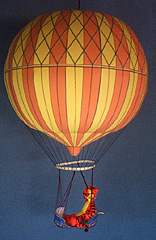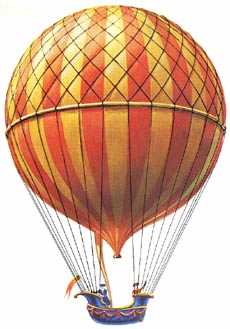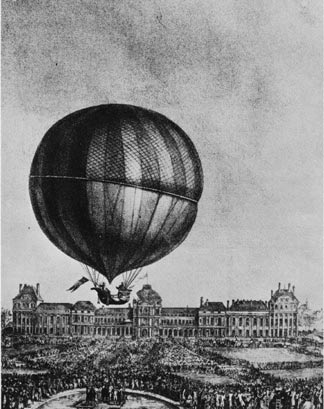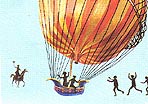


Charles Hydrogen Balloon - $$5.95
Gas balloons were used in the American Civil War, the Napoleonic Wars (to very limited extent), and throughout the 19th century by hobbyists and show performers such as the Blanchards. Curiously, after flying to an altitude of over 3000 m on his first flight, Professor Charles never flew again.
Jacques Alexander Cesar Charles Balloon Model

Jacques Alexandre Charles and Marie-Noel Robert made the first flight in a hydrogen balloon in December of 1783. They rose about 2,000 feet . Then while Marie-Noel stepped out of the basket under the balloon, the balloon was relieved of his weight. Charles shot up to over 9,000 feet.
Once again, great work!! I must be the only guy around with a good portion of his hard drive populated with card models. (not to mention the ones I built that are in the family room). If this keeps up, I'll have the entire computer dedicated to this stuff!!! Von Ric
Alexander Cesar Charles Balloon Model from Fiddlersgreen.net
 In December 1783, Jacques Alexander Cesar Charles, member
of the French Academy of Sciences, made a flight in a balloon filled with
hydrogen, which is one fourteenth the weight
of air.
In December 1783, Jacques Alexander Cesar Charles, member
of the French Academy of Sciences, made a flight in a balloon filled with
hydrogen, which is one fourteenth the weight
of air.
Henry Cavendish had discovered hydrogen in 1766, but this was the first time anyone had used it in a large balloon. Actually, Charles had the misconception that the Montgolfiers had been filling their balloons with hydrogen instead of hot air, i.e. "Montgolfier gas." This mistake led to the creation of a different kind of aerostat and furthered the progress of lighter-than-air craft.
The hot air balloon, with its requirement of an open fire, was rather dangerous. Hydrogen, although inflammable was completely enclosed in the balloon before liftoff. In fact the free balloon of today, though it uses the non combustible element helium in place of hydrogen, is similar in all its essentials to the balloon design of Charles.
The Charles balloon got up to 3000 feet and traveled about 16
miles in 45 minutes. The flight was successful, but so unfamiliar
that it inspired terror. As Charles landed just outside Paris
the local peasants, thinking that the "monster" was
sent by vengeful neighbors, hurled rocks at it and destroyed the
balloon. A Paris journal describes the event. "The creature,
shaking and bounding, dodged the first blows.
Finally, however, it received a mortal wound, and collapsed with a long sigh." A village man stuck his knife into the balloon and when the victors had decided it was dead they tied it to a horse and dragged it to the village. To prevent further incidents the government issued a proclamation stating that a balloon "is only a machine, made of taffetas, that will someday prove serviceable to the wants of society."
For his next flight Charles had a new balloon and 400,000 spectators. Parisians were so enthusiastic about this new phenomenon that hundreds helped to finance the building of the balloon by paying one crown apiece for the privilege of a "close-up view" of the anticipated take-off from a special enclosure. Benjamin Franklin, the 77 year old scientist-philosopher and diplomatic representative to France from the newly formed United States of America, was among the many who contributed to and saw the flight.
Further...
J. A. C. Charles - the inventor of the hydrogen balloon The bal1oon experiments of the Montgolfier brothers aroused much excitement in French scientific circles and the Academie in Paris invited them to the capital of France for a demonstration there. Before this came about, however, one of the youngest and most promising members of the Academy, the physicist Jacques Alexandre Cesar Charles (1746-1823), offered to turn out a ba1loon in cooperation with two skil1ed engineers and craftsmen, the Robert brothers.
The Academy accepted this offer and money was col1ected for the building of a relatively sma1l spherical bal1oon, of 13ft diameter, with an envelope made of rubberized silk, and for the equipment with which to develop the newly-discovered gas, hydrogen. For the intended filling of the bal1oon about 2,100 cu.ft of the gas would be required, and this quantity was to be procured by pouring sulphuric acid and water on to iron filings in a barrel.
The resulting hydrogen was to be fed to the balloon through a connecting hose from the barrel. Several associated difficulties, such as the high heat and steam also created, had first to be surmounted, after which Charles fixed the date for the first ascent of his balloon, which he named Globe.
The ascent was to take place on 27 August 1783 from the Champ de Mars in Paris, where the Eiffel Tower is now located. On the previous night the balloon was transferred there from the workshop at Place des Victoires, but the ascent first planned had to be abandoned because the crowds which were expected to congregate there would have been too large.
When the balloon ascended, practically all the inhabitants of Paris, beaded by the members of the Academy, seemed to have gathered to witness the event. After some supplementary gas had been added to the Globe the firing of a gun announced that the balloon was about to ascend. It took off during a shower and disappeared behind the roofs in a north-easterly direction. Three-quarters of an hour later the balloon landed in the small village of Gonesse, some six miles away from Paris, and there caused great consternation. The frightened farmers took the balloon for a monster and attacked it with pitchforks, scythes and blunderbusses.
 Some months later Charles and the Robert brothers were ready with
another balloon which could carry two men, but by then de Rozier
and d'Arlandes had already been aloft in their hot-air balloon.
However, the other team had been far-seeing and meanwhile made
such progress that the gas-filled balloon they had now created,
with a diameter of 26.75 ft, was perfected at once except for
minor alterations and has remained the standard type in use throughout
the centuries.
Some months later Charles and the Robert brothers were ready with
another balloon which could carry two men, but by then de Rozier
and d'Arlandes had already been aloft in their hot-air balloon.
However, the other team had been far-seeing and meanwhile made
such progress that the gas-filled balloon they had now created,
with a diameter of 26.75 ft, was perfected at once except for
minor alterations and has remained the standard type in use throughout
the centuries.
The new, large balloon was now provided with an open neck serving as a safety valve, which Globe had lacked. Deservedly, the name of the inventor is perpetuated in the 'Charliere' descriptive term bestowed on the gas-filled balloon.
The passenger-carrying basket was shaped and decorated after the fashions of its day, somewhat after the style of the small cars found in today's merry-go-rounds. It must have been quite a problem how to suspend these fancy, but rather unpractical, gondolas properly from the balloon envelope.
The balloon ascent of Charles, accompanied by the elder of the Robert brothers, Marie-Noel, started from the Tuileries Gardens on 1 December 1783 and was witnessed by some 400,000 people. The American scientist and statesman, Benjamin Franklin, was among those who witnessed the glorious spectacle.
In spite of the advanced season the weather was favorable for a balloon ascent. Charles inaugurated the sensible practice of launching a small pilot balloon (his was of a bright green color, hence long visible) prior to his own ascent to give him an idea in which direction, and how strongly, the wind was blowing. As a courteous deference to Joseph Montgolfier, who was in the crowd, he asked the latter to release the small pilot balloon.
 After
a gun-shot had announced that the balloon was ready to take off,
it rose successfully at 1:45 p.m. to the accompaniment of cheering
shouts from the crowds. Two hours later the two men floated at
an altitude of 820 ft south-west of Paris. At sunset Charles
decided to descend in a field near the small town of Nesles, some
31 miles from the French capital.
After
a gun-shot had announced that the balloon was ready to take off,
it rose successfully at 1:45 p.m. to the accompaniment of cheering
shouts from the crowds. Two hours later the two men floated at
an altitude of 820 ft south-west of Paris. At sunset Charles
decided to descend in a field near the small town of Nesles, some
31 miles from the French capital.
It was a smooth landing, and there were plenty of willing helpers to hold the basket on the ground. One of the first to arrive was the Duc de Chartres who, with friends, had pursued the balloon on horseback. Charles wrote a brief account of the balloon trip and the landing was duly certified by the local authorities.
The sun was down by now, but Charles was in such high spirits
after his adventures during the day that he decided to ascend
once more, but this time alone because the balloon had lost some
of its hydrogen. In spite of this the balloon climbed rapidly,
attaining an altitude of about 9,840 ft, where Charles
caught his second glimpse of the sun that day.
 His ears began
to ache badly, so he hurriedly valved gas, whereupon the balloon
began to descend. Charles threw out some ballast and then landed
gently near Tour du Lay, not very far from Nesles, after having
stayed in the air for about half an hour the second time. The
following day the balloon was returned to Paris in triumph.
His ears began
to ache badly, so he hurriedly valved gas, whereupon the balloon
began to descend. Charles threw out some ballast and then landed
gently near Tour du Lay, not very far from Nesles, after having
stayed in the air for about half an hour the second time. The
following day the balloon was returned to Paris in triumph.
In spite of this successful first trip, Charles never made another balloon ascent. His second venture into the upper air regions had likely been too much of an experience. It remains only to report that Charles and the Robert brothers also built an elongated balloon ordered by the Duc de Chartres, who had become a keen balloon enthusiast.
The duke almost paid for this balloon with his life as, strangely enough, it was not equipped with a safety valve.


